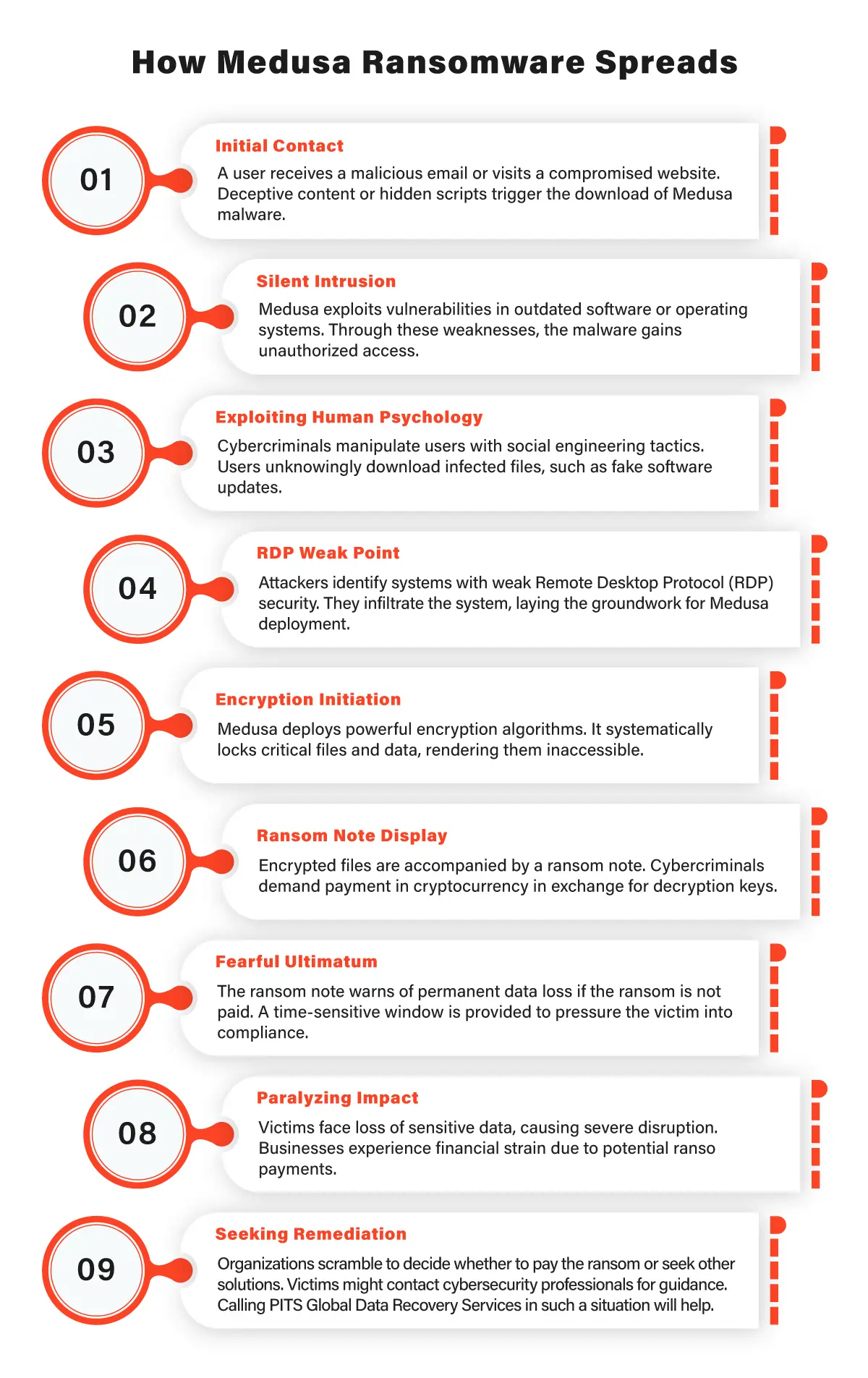In recent years, cybercrime has witnessed an alarming evolution, with ransomware attacks being at the forefront of this digital menace. Among the numerous variants of ransomware, Medusa has emerged as one of the most potent and malicious threats. In this blog post, we will delve into the world of Medusa ransomware and explore the escalating landscape of ransomware attacks.
Understanding Medusa Ransomware
Medusa ransomware is a sophisticated form of malware that encrypts files on a victim’s system, rendering them inaccessible until a ransom is paid to the attackers. Named after the mythical Greek monster with serpent hair, this malicious software shares a resemblance in the way it paralyzes its victims, holding their data hostage.
Once infected, Medusa encrypts sensitive files using strong encryption algorithms, making it nearly impossible for victims to regain access without the decryption key. Typically, cybercriminals behind Medusa ransomware demand a hefty ransom, often in cryptocurrencies like Bitcoin, to restore the encrypted data.

The Escalation of Ransomware Attacks
Ransomware attacks, including those using Medusa, have witnessed a dramatic escalation in both frequency and severity over the years. Several factors contribute to this troubling trend:
Lucrative Business Model
Ransomware attacks have proven to be lucrative for cybercriminals, enabling them to extort significant amounts of money from individuals and organizations desperate to recover their data.
Anonymity Through Cryptocurrencies
The use of cryptocurrencies as a preferred method of ransom payment allows cybercriminals to remain anonymous, making it challenging for law enforcement agencies to trace and apprehend them.
Advanced Techniques
Cybercriminals continue to enhance their attack techniques, using sophisticated tools and evasive tactics to avoid detection and improve their success rates.
Targeting Critical Infrastructure
In recent times, ransomware gangs have shifted their focus towards critical infrastructure, such as healthcare facilities, government agencies, and large corporations. These high-profile targets amplify the impact of attacks and increase the likelihood of receiving a hefty ransom.
Protecting Against Ransomware Attacks
Prevention is always better than cure when it comes to ransomware attacks. To safeguard against the menace of Medusa and other ransomware variants, individuals and organizations can implement the following proactive measures:
Security Awareness Training
Educate employees and users about the risks of phishing emails and the importance of avoiding suspicious links and attachments.
Regular Data Backups
Maintain regular backups of critical data on offline or secure cloud storage, ensuring the ability to recover data without paying the ransom.
Patch Management
Keep all software and operating systems up to date with the latest security patches to prevent exploitation of known vulnerabilities.
Robust Security Software
Deploy robust antivirus and anti-malware solutions that can detect and block ransomware threats effectively.
The rise of Medusa ransomware and the surge in ransomware attacks are significant warning signs of the evolving cyber threatscape. Cybercriminals are relentless in their pursuit of exploiting vulnerabilities for financial gain, making it imperative for individuals and organizations to take a proactive stance against ransomware attacks.
By staying vigilant, implementing robust security measures, and fostering a cybersecurity-conscious culture, we can collectively fortify ourselves against the looming threat of Medusa ransomware and other malicious software. Only through collective effort can we build a safer digital world for everyone.
Frequently Asked Questions
What is Medusa Ransomware?
Medusa Ransomware is a type of malicious software designed to encrypt files on a victim’s computer, making them inaccessible. The attackers then demand a ransom from the victim in exchange for the decryption key required to regain access to their data.
How does Medusa Ransomware infect systems?
Medusa Ransomware primarily spreads through phishing emails, malicious attachments, or links. When users unknowingly interact with these infected elements, the ransomware gains entry into their systems, initiating the encryption process.
What happens after Medusa Ransomware infects a system?
Once Medusa Ransomware infects a system, it quickly encrypts the victim’s files using powerful encryption algorithms. After the encryption process is complete, a ransom note is displayed, providing instructions on how to pay the ransom to receive the decryption key.
Can I recover my data without paying the ransom?
It is generally not recommended to pay the ransom, as there is no guarantee that the attackers will provide the decryption key or that it will work effectively. The best approach is to maintain regular backups of your data, so you can restore it without paying the ransom.
How can I protect my system from Medusa Ransomware?
Protect your system from Medusa Ransomware and other similar threats by:
- Being cautious with email attachments and links, especially from unknown sources.
- Keeping your operating system and software up to date with the latest security patches.
- Using reputable antivirus and anti-malware software to detect and prevent ransomware infections.
- Regularly backing up your critical data to an external drive or secure cloud storage.
